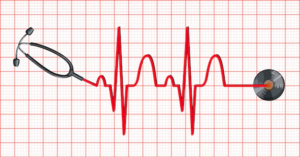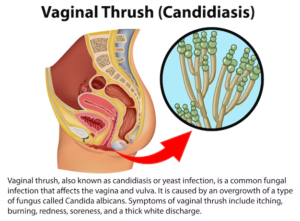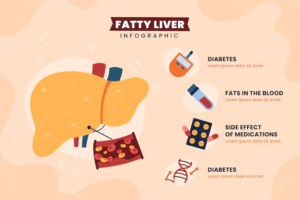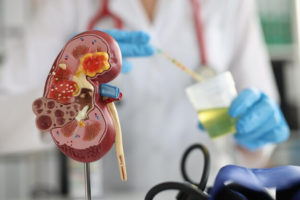Understanding Hyperlipidemia: Causes, Risks, and Management
Understanding Hyperlipidemia: Causes, Risks, and Management, often referred to as high cholesterol or high lipid levels, is a condition characterized by elevated levels of lipids (fats) in the blood. This condition can lead to serious health issues, including cardiovascular diseases, heart attacks, and strokes. In this blog, we will delve into the causes, risk factors, implications, and management strategies for hyperlipidemia, equipping you with the knowledge to take proactive steps toward maintaining healthy lipid levels.
What is Hyperlipidemia?

Hyperlipidemia refers to the increased concentration of lipids in the bloodstream. The most common types of lipids include cholesterol and triglycerides. Cholesterol, a waxy substance produced by the liver and also found in certain foods, is essential for building cells and producing hormones. However, when levels become too high, particularly the low-density lipoprotein (LDL) cholesterol, it can lead to the development of fatty deposits in blood vessels, increasing the risk of heart disease.
Types of Lipids
- Cholesterol:
- Low-Density Lipoprotein (LDL): Often termed “bad” cholesterol, high levels can lead to plaque buildup in arteries.
- High-Density Lipoprotein (HDL): Known as “good” cholesterol, it helps remove other forms of cholesterol from the bloodstream.
- Triglycerides: A type of fat found in the blood, high levels can also contribute to the hardening and narrowing of arteries.
Causes of Hyperlipidemia
Several factors can contribute to hyperlipidemia:
- Genetics: Familial hypercholesterolemia is an inherited condition that results in very high levels of LDL cholesterol.
- Diet: A diet high in saturated fats, trans fats, and cholesterol can elevate lipid levels. Foods such as red meat, full-fat dairy products, and processed snacks are common culprits.
- Obesity: Excess body weight, particularly abdominal fat, is linked to increased cholesterol and triglyceride levels.
- Sedentary Lifestyle: Physical inactivity can contribute to weight gain and increased lipid levels.
- Medical Conditions: Certain conditions such as diabetes, hypothyroidism, and kidney disease can influence lipid metabolism.
- Medications: Some medications, including steroids and diuretics, can affect lipid levels.
- Alcohol Consumption: Excessive alcohol intake can lead to high triglyceride levels.
Risk Factors
Understanding the risk factors for hyperlipidemia is crucial in identifying individuals who may be more prone to this condition. Common risk factors include:
- Age: Risk increases with age, especially in men over 45 and women over 55.
- Family History: A family history of heart disease or high cholesterol can elevate risk.
- Smoking: Tobacco use can lower HDL cholesterol and damage blood vessels.
- Chronic Conditions: Conditions like diabetes and high blood pressure can exacerbate hyperlipidemia.
- Gender: Men tend to have higher cholesterol levels at a younger age compared to women, although post-menopause, women’s levels may increase.
Health Implications of Hyperlipidemia
The primary health concern associated with hyperlipidemia is its link to cardiovascular diseases. When cholesterol accumulates in the walls of arteries, it forms plaques that narrow and harden the arteries, a condition known as atherosclerosis. This can lead to:
- Coronary Artery Disease: Reduced blood flow to the heart can result in angina or heart attacks.
- Stroke: Plaques can also form in arteries supplying blood to the brain, leading to a stroke.
- Peripheral Artery Disease: Reduced blood flow to limbs can cause pain and complications.
Diagnosing Hyperlipidemia
Hyperlipidemia is typically diagnosed through a blood test known as a lipid panel, which measures:
- Total cholesterol
- LDL cholesterol
- HDL cholesterol
- Triglycerides
It’s recommended that adults have their lipid levels checked every four to six years, starting at age 20. Those with risk factors may need more frequent testing.
Management Strategies
Managing hyperlipidemia involves lifestyle changes, and in some cases, medication. Here are some effective strategies:
1. Dietary Changes
- Increase Fiber Intake: Foods high in soluble fiber, such as oats, beans, lentils, fruits, and vegetables, can help lower LDL levels.
- Choose Healthy Fats: Replace saturated fats found in red meat and full-fat dairy with healthier fats like those in olive oil, avocados, and nuts.
- Limit Trans Fats: Avoid processed foods containing hydrogenated oils, which raise LDL cholesterol.
- Eat More Fish: Fatty fish, like salmon and mackerel, are high in omega-3 fatty acids, which can lower triglycerides.
2. Physical Activity
Engaging in regular physical activity can help raise HDL cholesterol and lower LDL cholesterol and triglycerides. Aim for at least 150 minutes of moderate aerobic exercise per week, such as brisk walking, swimming, or cycling.
3. Weight Management
Achieving and maintaining a healthy weight can significantly impact lipid levels. Even a modest weight loss of 5-10% can improve cholesterol levels.
4. Avoid Tobacco and Limit Alcohol
Quitting smoking can improve HDL cholesterol levels and overall heart health. Limiting alcohol intake can help manage triglyceride levels.
5. Medications
For some individuals, lifestyle changes alone may not be sufficient to manage hyperlipidemia. In such cases, healthcare providers may prescribe:
- Statins: These medications reduce LDL cholesterol levels.
- Fibrates: Primarily effective at lowering triglyceride levels.
- Bile Acid Sequestrants: Help reduce cholesterol levels by blocking its absorption.
- PCSK9 Inhibitors: Newer class of drugs that can significantly lower LDL cholesterol.
Regular Monitoring and Follow-Up
Once diagnosed, it’s important to have regular follow-ups with a healthcare provider to monitor lipid levels and adjust treatment as necessary. Regular check-ups also provide an opportunity to address other risk factors and overall heart health.
Conclusion
Understanding Hyperlipidemia: Causes Risks and Management is a prevalent condition that can lead to serious health complications if left unmanaged. By understanding the causes, risk factors, and management strategies, individuals can take proactive steps to maintain healthy lipid levels. Implementing dietary changes, increasing physical activity, managing weight, and, if necessary, taking medications can significantly reduce the risks associated with hyperlipidemia. Regular monitoring and open communication with healthcare providers are vital in maintaining heart health and preventing cardiovascular diseases. By prioritizing lifestyle changes and making informed choices, you can effectively manage hyperlipidemia and promote overall well-being.








Leave a reply